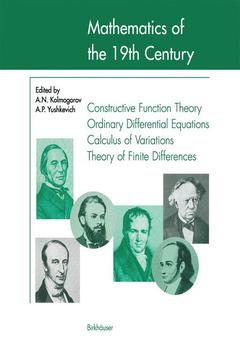Description
Mathematics of the 19th Century, Softcover reprint of the original 1st ed. 1998
Function Theory According to Chebyshev Ordinary Differential Equations Calculus of Variations Theory of Finite Differences
Coordinators: Kolmogorov A.N., Yushkevich A.P.
Language: English
Publication date: 11-2012
353 p. · 15.5x23.5 cm · Paperback
353 p. · 15.5x23.5 cm · Paperback
Description
/li>Contents
/li>
The editors of the present series had originally intended to publish an integrated work on the history of mathematics in the nineteenth century, passing systemati cally from one discipline to another in some natural order. Circumstances beyond their control, mainly difficulties in choosing authors, led to the abandonment of this plan by the time the second volume appeared. Instead of a unified mono graph we now present to the reader a series of books intended to encompass all the mathematics of the nineteenth century, but not in the order of the accepted classification of the component disciplines. In contrast to the first two books of The Mathematics of the Nineteenth Century, which were divided into chapters, this third volume consists of four parts, more in keeping with the nature of the publication. 1 We recall that the first book contained essays on the history of mathemati 2 cal logic, algebra, number theory, and probability, while the second covered the history of geometry and analytic function theory. In the present third volume the reader will find: 1. An essay on the development of Chebyshev's theory of approximation of functions, later called "constructive function theory" by S. N. Bernshtein. This highly original essay is due to the late N. I. Akhiezer (1901-1980), the author of fundamental discoveries in this area. Akhiezer's text will no doubt attract attention not only from historians of mathematics, but also from many specialists in constructive function theory.
1 Function Theory According to Chebyshev.- 1.1 Introduction.- 1.2 Functions of Minimal Deviation from Zero.- 1.2.1 The Lectures of A. A. Markov.- 1.2.2 E.I. Zolotaryov’s Problems; V. A. Markov’s Inequality.- 1.2.3 The Chebyshev Problem of Geographic Map Construction.- 1.3 Continued Fractions.- 1.3.1 Special Systems of Orthogonal Polynomials.- 1.3.2 Parameter-Dependence of the Zeros of Polynomials Obtained by Converting Series into Continued Fractions.- 1.3.3 Research on Bounds for Integrals.- 1.4 Conclusion.- 2 Ordinary Differential Equations.- 2.1 Summary of the Development of Ordinary Differetial Equations in the Eighteenth-Century.- 2.2 The Problem of Existence and Uniqueness.- 2.2.1 The Work of Cauchy.- 2.2.2 Development of the Method of Majorants.- 2.2.3 The Cauchy-Lipschitz Method.- 2.2.4 The Method of Successive Approximations.- 2.3 Integration of Equations in Quadratures.- 2.3.1 Liouville and the Riccati Equation.- 2.3.2 New Classes of Integrable Equations.- 2.3.3 Sophus Lie and the Problem of Integrability of Differential Equations in Quadratures.- 2.3.4 Singular Solutions.- 2.4 Linear Differential Equations.- 2.4.1 The General Theory.- 2.4.2 Boundary-value Problems. Sturm-Liouville Theory.- 2.4.3 Solution of Equations in Series and Special Functions.- 2.5 The Analytic Theory of Differential Equations.- 2.5.1 Origins of the Cauchy Theory. The Work of Briot and Bouquet.- 2.5.2 Bernhard Riemann.- 2.5.3 Lazarus Fuchs.- 2.5.4 Henri Poincaré.- 2.5.5 Nonlinear Equations.- 2.5.6 The Research of the Russian Mathematicians.- 2.5.7 Paul Painlevé.- 2.6 The Qualitative Theory of Differential Equations.- 2.6.1 Poincaré’s Qualitative Theory.- 2.6.2 Lyapunov’s Theory of Stability.- 2.6.3 Later Development of the Qualitative Theory of Differential Equations.- 2.6.4 Conclusion.- 3 The Calculus of Variations.- 3.1 Introduction.- 3.2 Calculus of Variations in the First Half of the Nineteenth Century.- 3.2.1 The Theory of Extrema of Multiple Integrals.- 3.2.2 The Hamilton-Jacobi Theory.- 3.2.3 Sufficient Conditions for a Weak Extremum.- 3.3 Calculus of Variations in the Second Half of the Nineteenth Century.- 3.3.1 The Proofs of the Jacobi Criterion and its Clarification. The Problem of Distinguishing Weak and Strong Extrema.- 3.3.2 Weierstrass’ Calculus of Variations.- 3.3.3 The Theory of the Simplest Variational Problem in the Second Half of the Nineteenth Century.- 3.3.4 The Creation of Field Theory.- 3.3.5 The Isoperimetric Problem.- 3.3.6 The Problems of Lagrange, Mayer, and Bolza.- 3.4 Conclusion. On Some Trends in the Development of the Calculus of Variations at the Turn of the Twentieth Century.- 4 The Calculus of Finite Differences.- 4.1 Interpolation.- 4.1.1 Finite Interpolation.- 4.1.2 Laplace’s Interpolation Series.- 4.1.3 Abel’s Interpolating Series.- 4.1.4 An Estimate of the Remainder in the Lagrange Interpolation Formula.- 4.1.5 Analytic Methods in the Theory of Interpolation.- 4.2 The Euler-Maclaurin Summation Formula.- 4.2.1 The Problem of Summation.- 4.2.2 Semiconvergent Series. Legendre’s Research.- 4.2.3 Poisson’s Derivation of the Summation Formula with Remainder.- 4.2.4 Abel’s Derivation.- 4.2.5 Jacobi’s Derivation. Enveloping Conditions.- 4.2.6 The Summation Formula according to Ostrogradskii.- 4.3 Finite-Difference Equations.- 4.3.1 Statement of the Problem. Summary of the Development of the Theory in the Eighteenth Century.- 4.3.2 Laplace’s Method.- 4.3.3 Poincaré’s Research.- 4.4 Conclusion.- Abbreviations Used for Multivolume and Periodical Publications.- A. General Works.- B. Collected Works and Classical Editions.- Literature to Part 1.- Literature to Part 2.- Literature to Part 3.- Literature to Part 4.- Index of Names.
© 2024 LAVOISIER S.A.S.




